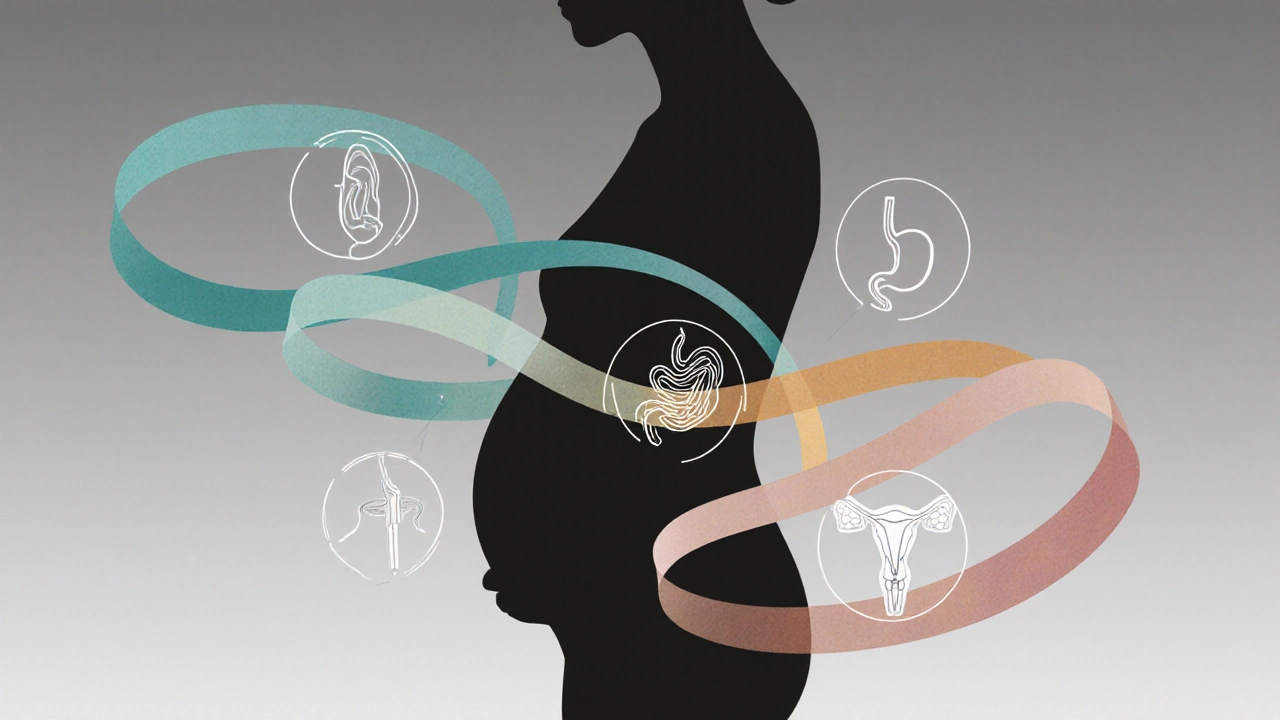Morning Sickness Severity Checker
Assess Your Symptoms
This tool helps you understand how severe your nausea might be and when to seek medical help.
Your Symptom Assessment
When you start feeling queasy after the first few weeks of pregnancy, you’re not alone. Many expectant mothers wonder why the body reacts this way and how to manage it. Below, we break down the science behind morning sickness, give you practical tips, and let you know when to call a professional.
Quick Takeaways
- Morning sickness is driven mainly by rapid hormonal shifts, especially estrogen and hCG.
- Eating small, frequent meals, staying hydrated, and using ginger or vitamin B6 can reduce nausea for most women.
- Severe vomiting, weight loss, or signs of dehydration require medical attention.
- Emotional support from partners, friends, or online groups helps you cope with the ups and downs.
- Most symptoms ease after the second trimester, but some women experience them longer.
What Is Morning Sickness?
Morning sickness is a common early‑pregnancy symptom that includes nausea, occasional vomiting, and heightened sensitivity to smells. Despite the name, it can strike at any time of day and affects up to 80% of pregnant people.
It’s not a sign of something wrong; rather, it’s a signal that your body is undergoing massive adjustments to nurture a new life.
Why Does It Happen? The Hormonal Story
Three hormones dominate the early‑pregnancy landscape:
- Estrogen is a hormone that rises sharply after implantation and can trigger nausea by affecting the brain’s vomit center.
- Human chorionic gonadotropin (hCG) is produced by the placenta; its rapid increase in the first weeks correlates with the peak of nausea.
- Progesterone is the hormone that relaxes the uterus but also slows stomach emptying, leading to a feeling of fullness and queasiness.
These hormonal surges interact with the digestive system, the inner ear, and the olfactory nerves, creating the classic nausea loop.

Physical Changes Your Body Goes Through
Beyond hormones, several physiological shifts matter:
- Stomach motility slows down, so food stays longer and can ferment, worsening the scent triggers.
- Blood volume expands by about 40%, which can dilute stomach acids and affect digestion.
- The placenta is the organ that forms to supply the embryo with oxygen and nutrients; its development is the source of hCG, which adds to the hormonal cocktail.
Typical Timeline and What to Expect
Nausea often starts around week 4-6, peaks between weeks 8 and 12, and then eases for most people by week 16. However, 10-15% continue to experience symptoms into the third trimester.
Key milestones:
- Weeks 4‑6: First wave of nausea as hCG spikes.
- Weeks 8‑12: Peak intensity; many find relief by adjusting diet.
- Weeks 13‑16: Hormone levels begin to plateau; nausea often lessens.
- After week 20: Most women report significant improvement, though a minority keep experiencing occasional queasiness.
Practical Ways to Ease Nausea
Below are evidence‑backed strategies you can try at home. Choose what feels right for you; often a combination works best.
- Small, frequent meals: Aim for 5‑6 mini‑meals a day to keep the stomach from emptying completely.
- Stay hydrated: Sip water, herbal teas, or electrolyte drinks throughout the day. Dehydration is a common side effect of vomiting that can worsen nausea and cause dizziness. Keep a bottle within arm’s reach.
- Ginger: Fresh ginger tea, ginger chews, or powdered ginger added to smoothies can reduce nausea in up to 70% of studies.
- Vitamin B6: 10-25mg daily, either through prenatal vitamins or a supplement, has been shown to lessen symptoms for many women.
- Acupressure: Pressing the P6 (Neiguan) point on the inner forearm for a few minutes before meals can provide relief. Acupressure is a non‑invasive technique that stimulates specific points to balance nausea pathways.
- Cold or bland foods: Crackers, plain toast, applesauce, and bananas are easier on the stomach.
- Avoid triggers: Strong odors, spicy foods, and overly rich meals often aggravate nausea.

Home Remedies vs. Over‑the‑Counter Options
| Approach | How it works | Typical cost (UK) | Safety during pregnancy |
|---|---|---|---|
| Ginger (fresh or supplement) | Anti‑inflammatory compounds calm the stomach lining | £0.50‑£2 per dose | Generally safe in moderate amounts |
| Vitamin B6 tablets | Supports neurotransmitter balance that reduces nausea signals | £3‑£5 for a month’s supply | Recommended by NHS up to 25mg/day |
| Diclegis (doxylamine‑pyridoxine) | Combines an antihistamine with B6 to block nausea pathways | Prescription; £15‑£20 per pack | Approved for use after first trimester |
| Pepto‑Bismol (bismuth subsalicylate) | Coats the stomach lining, reducing irritation | £4‑£6 per bottle | Not recommended in pregnancy; avoid |
When to Seek Medical Help
Most nausea is manageable, but watch for red flags that signal something more serious:
- Vomiting more than three times in 24hours.
- Weight loss of more than 5% of pre‑pregnancy weight.
- Persistent dehydration signs: dark urine, dizziness, dry mouth.
- Severe abdominal pain or fever.
If any of these appear, contact your midwife or GP promptly. Early intervention can prevent complications and keep both you and the baby healthy.
Emotional Side and Support
Morning sickness isn’t just physical-it can feel isolating and tiring. Sharing your experience with a partner, joining a local moms‑to‑be group, or posting in an online forum can provide validation and practical tips.
Mind‑body techniques such as gentle yoga, breathing exercises, or short meditation sessions can lower stress hormones, which in turn may lessen nausea.
Frequently Asked Questions
Can I eat breakfast if I feel nauseous?
Yes. A light, bland breakfast-like dry toast, a banana, or a small bowl of oatmeal-can settle the stomach before the day’s activities.
Is ginger safe to use daily?
Moderate amounts (up to 1g per day) are considered safe throughout pregnancy and have been shown to reduce nausea for many women.
How much vitamin B6 should I take?
The NHS recommends 10-25mg per day. Check your prenatal vitamin label or ask your healthcare provider for the right dosage.
When is it okay to use over‑the‑counter anti‑nausea meds?
Always consult a midwife before taking any medication. Some antihistamines (like doxylamine) are safe after the first trimester, but others, such as Pepto‑Bismol, are not recommended.
Why does nausea often get better after the second trimester?
Hormone levels start to stabilise, and the stomach regains its normal motility. By then, the placenta is fully functional, so the body no longer needs the protective “vomit response” that helped shield the embryo early on.

11 Responses
What they don’t want you to realize is that the surge of hCG and estrogen isn’t just a random side‑effect – it’s a calculated move by the pharmaceutical giants to keep us dependent on their anti‑nausea drugs. The body’s natural response to these hormones is to slow gastric emptying, which triggers that queasy feeling. They’ve engineered a market by labeling the discomfort as “morning sickness” and then flooding us with pricey ginger supplements and prescription meds that claim to “relieve” it. Meanwhile, the only real relief comes from simple home remedies and staying hydrated, which they conveniently downplay. So, while you’re Googling “how to stop nausea,” remember the real agenda behind the glittering product shelves.
It’s important to keep perspective-hormonal changes are a natural part of early pregnancy, and many people find genuine relief with ginger tea, small frequent meals, and plenty of water. While the market does push products, staying grounded in evidence‑based practices can make a big difference without breaking the bank. Let’s focus on what works for each individual and share tips that have helped us personally.
I think you should just try some crackers and water i mean it works for most people and if it doesn’t you can always see a doctor later
From a formal standpoint, the correlation between elevated human chorionic gonadotropin and nausea is well‑documented in obstetric literature. However, one must remain vigilant about the influence of commercial interests that promote proprietary treatments under the guise of scientific advancement. A judicious review of peer‑reviewed studies suggests that non‑pharmacologic interventions retain the highest efficacy‑to‑risk ratio.
One must consider that the body’s protective mechanisms are at play; the delicate balance of hormones can trigger nausea, yet simple measures like ginger, hydration, and rest often suffice. Overcomplicating the issue with boutique products rarely adds value.
Honestly, most of these articles overstate the drama. Morning sickness is just the body doing its job, not a conspiracy. If you’re looking for solutions, stick to basic things-water, bland food, and maybe a ginger chew. Anything fancy is just a cash‑grab.
Your nausea is just a test of willpower.
Dearest members, it is my pleasure to extend heartfelt empathy to those navigating the early stages of pregnancy. The physiological fluctuations, while universally experienced, manifest uniquely across cultures and individual histories. May you find solace in communal support, and may the gentle remedies of ginger, hydration, and mindful rest bring you comfort.
When you first feel that wave of nausea early in the morning, it can feel like the world is tilting on its axis and every breath is a struggle, especially when the hormones are doing a wild dance inside your body. The key is to listen to your stomach’s rhythm; it often tells you when to eat and when to pause. Small, bland meals such as toast, crackers, or plain rice can be a lifeline, because they are easy on the digestive tract and don’t overload it. Ginger, whether in tea, candied form, or as a supplement, has been shown in many studies to reduce nausea through its anti‑inflammatory properties. Hydration is another cornerstone-sip water or electrolyte solutions throughout the day rather than gulping large amounts at once. Vitamin B6, taken in modest doses, can also calm the queasy feeling, but always check with your provider before adding supplements. Acupressure bands that press on the P6 point have helped many people; they’re a non‑pharmacologic option that some find soothing. Rest is not just a luxury; the body needs downtime to adjust to the rapid hormonal changes, so don’t hesitate to nap when you feel fatigued. If you’re comfortable, try eating a piece of fruit like a banana, which offers potassium and gentle carbs. Avoid strong odors and spicy foods, as they can trigger the gag reflex. Warm soups or broths provide both hydration and nutrition without being too heavy. Some women find that eating a light snack before getting out of bed can preempt the nausea attack. Keep a notebook of what foods or activities seem to help or worsen the symptoms; patterns often emerge that you can act on. If vomiting becomes frequent, consider oral rehydration salts to replace lost electrolytes. Always have a trusted friend or partner aware of your situation so they can help with errands or meals when you need extra support. Lastly, remember that for most, morning sickness peaks around weeks 9‑12 and then gradually subsides as the body finds a new equilibrium. Patience, self‑care, and a supportive network can make this phase much more manageable.
Alright, let’s cut through the fluff-if you’re still reaching for overpriced “miracle” capsules after trying plain crackers and ginger tea, you’re probably chasing a rainbow while neglecting the basics. The body is a brilliant chemist; it knows when to signal distress. Ignoring that signal with a pricey pill is both reckless and, frankly, a touch ridiculous.
Thank you for sharing such a comprehensive overview. To distill the essentials: maintain steady hydration, incorporate ginger or vitamin B6 as tolerated, and prioritize small, frequent meals. If symptoms persist beyond the typical first trimester, seeking professional guidance is advisable. Your detailed list provides a solid roadmap for anyone navigating this challenging period.